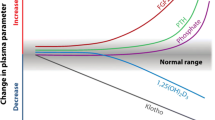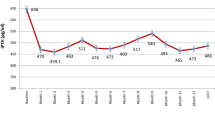Abstract
Purpose
The National Kidney Foundation Kidney Disease Outcomes Quality Initiative (NKF-K/DOQI™) 2003 and Kidney Disease: Improving Global Outcomes (KDIGO) 2009 have established guidelines for the treatement of secondary hyperparathyroidism. This study evaluated the impact of parathyroidectomy to achieve recommended values for parathyroid hormone, calcium, phosphorus and CaxPO4 product in dialysis patients with severe secondary hyperparathyroidism that is resistant to medical treatment.
Methods
This study included 43 consecutive patients who underwent parathyroidectomy for a severe form of secondary hyperparathyroidism (SHPT) that is unresponsive to medical treatment. The serum iPTH, calcium and phosphorus levels were measured prior to surgery, every morning after surgery for 5 days and on the first, sixth and eighth postoperative months.
Results
Following parathyroidectomy, a significant decline in iPTH values was observed in all patients; however, after the 8-month study period, only one of these patients achieved a serum iPTH concentration within the K/DOQI recommended target range. Unlike iPTH, targeting for calcium, phosphorus and CaxPO4 at the last follow-up were 55.8%, 60.5% and 93%, respectively. These values indicated a significant improvement in comparison to preoperative percentages. In regards to the KDIGO recommended guidelines, the iPTH levels did not significantly change at the end of our study compared to preoperative values; however, calcium levels significantly declined and phosphorus levels significantly improved compared to preoperative values.
Conclusions
Although the majority of patients fail to reach recommended iPTH values, parathyroidectomy remains a valuable tool to attain these NKF-K/DOQI recommendations for serum calcium, phosphorus and CaxPO4 in dialysis patients with secondary hyperparathyroidism resistant to medical therapy. Parathyroidectomy was shown to be an inadequate intervention for achieving KDIGO recommendations.






Similar content being viewed by others
References
Ganesh SK, Stack AG, Levin NW et al (2001) Association of elevated serum PO4, CaxPO4 product and parathyroid hormone with cardiac mortality risk in chronic hemodialysis patients. J Am Soc Nephrol 12:2131–8
Tentori F, Blayney MJ, Albert JM et al (2008) Mortality risk for dialysis patients with different levels of serum calcium, phosphorus and PTH: the Dialysis Outcomes and Practice Patterns Study (DOPPS). Am J Kidney Dis 52:519–30
Block GA, Hulbert-Shearon TE, Levin NW, Port FK (1998) Association of serum phosphorus and calcium × phosphate product with mortality risk in chronic hemodialysis patients: a national study. Am J Kidney Dis 31:607–17
Kimata N, Albert JM, Akiba T et al (2007) Association of mineral metabolism factors with all-cause and cardiovascular mortality in hemodialysis patients: the Japan Dialysis Outcomes and Practice Patterns Study. Hemodial Int 11:340–8
Young EW, Albert JM, Satayathum S et al (2005) Predictors and consequences of altered mineral metabolism: the Dialysis Outcomes and Practice Patterns Study. Kidney Int 67:1179–87
National Kidney Foundation (2003) K/DOQI clinical practice guidelines: bone metabolism and disease in chronic kidney disease. Am J Kidney 42:S1–S201
Danese MD, Belozeroff V, Smirnakis K, Rothman KJ (2008) Consistent control of mineral and bone disorder in incident hemodialysis patients. Clin J Am Soc Nephrol 3:1423–1429
Noordzij M, Korevaar JC, Boeschoten EW, Dekker FW, Bos WJ, Krediet RT (2005) The Kidney Disease Outcomes Quality Initiative (K/DOQI) guideline for bone metabolism and disease in CKD: association with mortality in dialysis patients. Am J Kidney Dis 46:925–932
Al Aly Z, Gonzalez EA, Martin KJ, Gellens ME (2004) Achieving K/DOQI laboratory target values for bone and mineral metabolism: an uphill battle. Am J Nephrol 24:422–426
Arenas MD, Alvarez-Ude F, Gil MT et al (2006) Application of NKF-K/DOQI clinical practice guidelines for bone metabolism and disease: changes of clinical practices and their effects on outcomes and quality standards in three haemodialysis units. Nephrol Dial Transplant 21:1663–1668
Block GA, Martin KJ, de Francisco AL et al (2004) Cinacalcet for secondary hyperparathyroidism in patients receiving hemodialysis. N Engl J Med 350:1516–25
Lindberg JS, Culleton B, Wong G et al (2005) Cinacalcet HCl, an oral calcimimetic agent for the treatment of secondary hyperparathyroidism in hemodialysis and peritoneal dialysis: a randomized, double-blind, multicenter study. J Am Soc Nephrol 16:800–7
Ureña P, Jacobson SH, Zitt E et al (2009) Cinacalcet and achievement of the NKF/K-DOQI recommended target values for bone and mineral metabolism in real-world clinical practice—the ECHO observational study. Nephrol Dial Transplant 24:2852–9
Moe SM, Chertow GM, Coburn JW et al (2005) Achieving NKF-K/DOQI bone metabolism and disease treatment goals with cinacalcet HCl. Kidney Int 67:760–71
Kidney Disease: Improving Global Outcomes (KDIGO) CKD–MBD Work Group (2009) KDIGO clinical practice guideline for the diagnosis, evaluation, prevention, and treatment of chronic kidney disease–mineral and bone disorder (CKD–MBD). Kidney Int 76(Suppl 113):S1–S130
Schneider R, Kolios G, Koch BM, Fernández ED, Bartsch DK, Schlosser K (2010) An economic comparison of surgical and medical therapy in patients with secondary hyperparathyroidism—the German perspective. Surgery 148:1091–9
Narayan R, Perkins RM, Berbano EP et al (2007) Parathyroidectomy versus cinacalcet hydrochloride-based medical therapy in the management of hyperparathyroidism in ESRD: a cost utility analysis. Am J Kidney Dis 49:801–13
Tominaga Y, Matsuoka S, Uno N, Sato T (2008) Parathyroidectomy for secondary hyperparathyroidism in the era of calcimimetics. Ther Apher Dial 12(Suppl 1):S21–S26
Mazzaferro S, Pasquali M, Farcomeni A et al (2008) Parathyroidectomy as a therapeutic tool for targeting the recommended NKF-K/DOQI ranges for serum calcium, phosphate and parathyroid hormone in dialysis patients. Nephrol Dial Transplant 23:2319–2323
Gal-Moscovici A, Popovtzer MM (2005) New worldwide trends in presentation of renal osteodystrophy and its relationship to parathyroid hormone levels. Clin Nephrol 63:284–9
Barreto FC, Barreto DV, Moysés RM et al (2008) K/DOQI-recommended intact PTH levels do not prevent low-turnover bone disease in hemodialysis patients. Kidney Int 73:771–7
Kestenbaum B, Andress DL, Schwartz SM et al (2004) Survival following parathyroidectomy among United States dialysis patients. Kidney Int 66:2010–6
Dukkipati R, Kovesdy CP, Colman S et al (2010) Association of relatively low serum parathyroid hormone with malnutrition–inflammation complex and survival in maintenance hemodialysis patients. J Ren Nutr 20:243–54
Costa-Hong V, Jorgetti V, Gowdak LH, Moyses RM, Krieger EM, De Lima JJ (2007) Parathyroidectomy reduces cardiovascular events and mortality in renal hyperparathyroidism. Surgery 142:699–703
Goldsmith DJ, Covic AA, Venning MC, Ackrill P (1997) Blood pressure reduction after parathyroidectomy for secondary hyperparathyroidism: further evidence implicating calcium homeostasis in blood pressure regulation. Am J Kidney Dis 29:593–600
Coen G, Calabria S, Bellinghieri G et al (2001) Parathyroidectomy in chronic renal failure: short- and long-term results on parathyroid function, blood pressure and anemia. Nephron 88:149–55
Conflicts of interest
None.
Author information
Authors and Affiliations
Corresponding author
Rights and permissions
About this article
Cite this article
Kovacevic, B., Ignjatovic, M., Zivaljevic, V. et al. Parathyroidectomy for the attainment of NKF-K/DOQI™ and KDIGO recommended values for bone and mineral metabolism in dialysis patients with uncontrollable secondary hyperparathyroidism. Langenbecks Arch Surg 397, 413–420 (2012). https://doi.org/10.1007/s00423-011-0901-9
Received:
Accepted:
Published:
Issue Date:
DOI: https://doi.org/10.1007/s00423-011-0901-9




